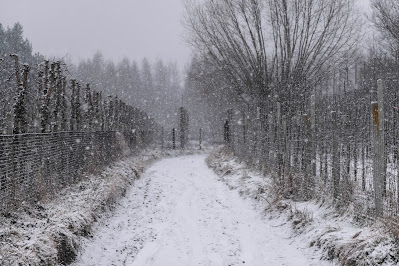Walking around Jakubowizna and district, I see plenty of wild deer; elk are rarer (two sightings in five and half years). Females tend to roam in small groups of between three to six individuals, while males, like this young one below, tend to be solitary.
Jakubowizna has a large pheasant population; this rather wet chappie I snapped from my bedroom window one rainy Lenten morn.
Below: Eurasian blue tit (modraszka zwyczajna or sikora modra, Cyanistes caeruleus ) from my kitchen window. There's quite a flock of these in my garden.
The buzzard is the most common bird of prey around Jakubowizna. Often seen hovering over forests, the buzzard feeds on voles and other small mammals as well a fledgling birds, which is why crows tend to mob them in flight, especially during the nesting season. Below: a long way off (crop from a 300mm zoom)
The jay (sójka zwyczajna, Garrulus glandarius) is a colourful and frequent visitor, also snapped from the kitchen window. Note the first sign of leaves appearing.
If the grey heron is the wetland bird of Jeziorki, around Jakubowizna it is the crane (żuraw zwyczajny, Grus grus). Larger (and noisier) than herons, cranes also nest among reeds, they have a wingspan of over two metres, weighing up to 6kg.
This time last year:
Fasting and Temptation
This time two years ago:
Long walk, back in the swing
Speeches for Leaders, by Charles Crawford
This time eight years ago:
In Memoriam - those who died at Smolensk
This time ten years ago:
Warszawa 1935: 3D film reconstructs lost city
This time 11 years ago:
Cats and consciousness
This time 13 years ago:
Smolensk - why did this happen?
This time 14 years ago:
Britain's grey squirrels turning red

















No comments:
Post a Comment